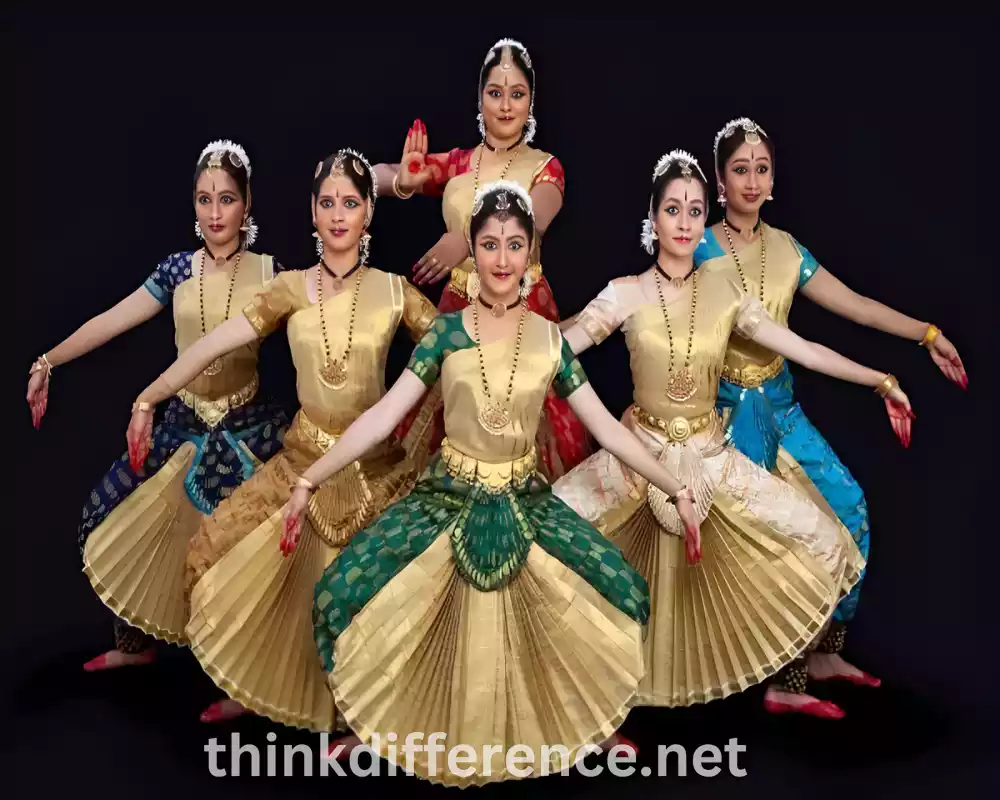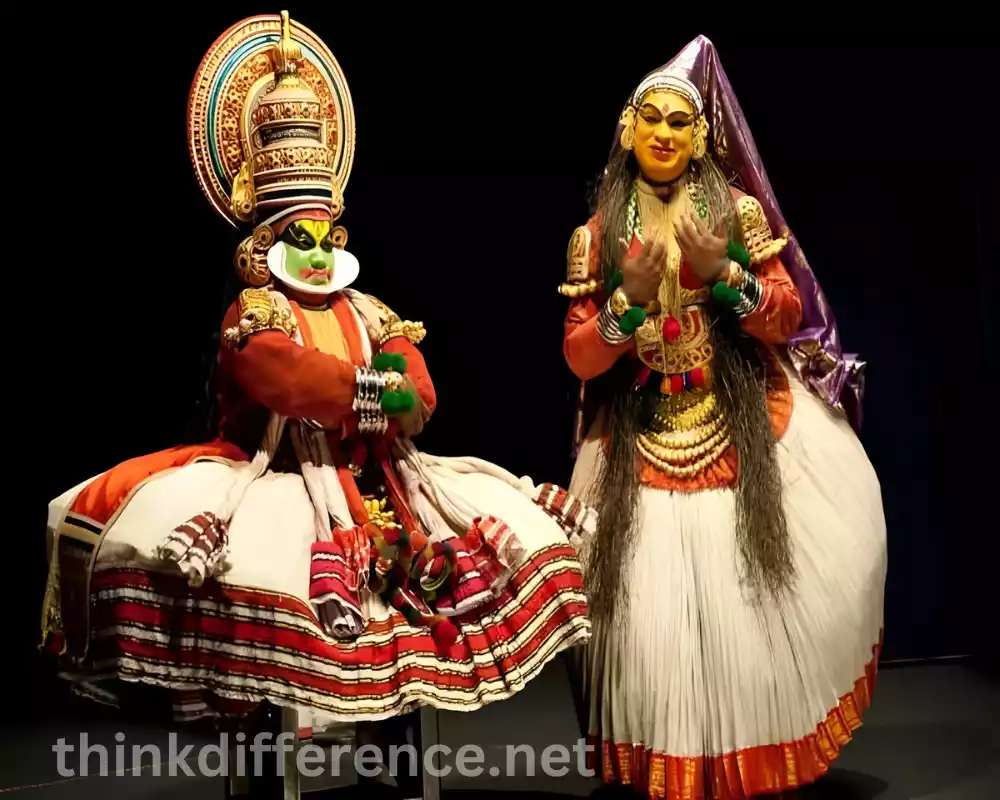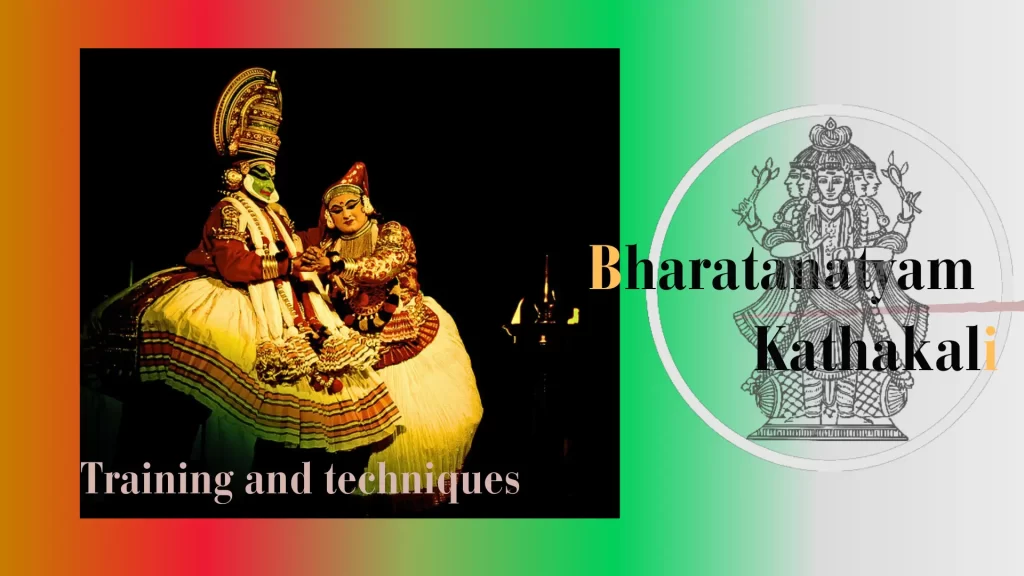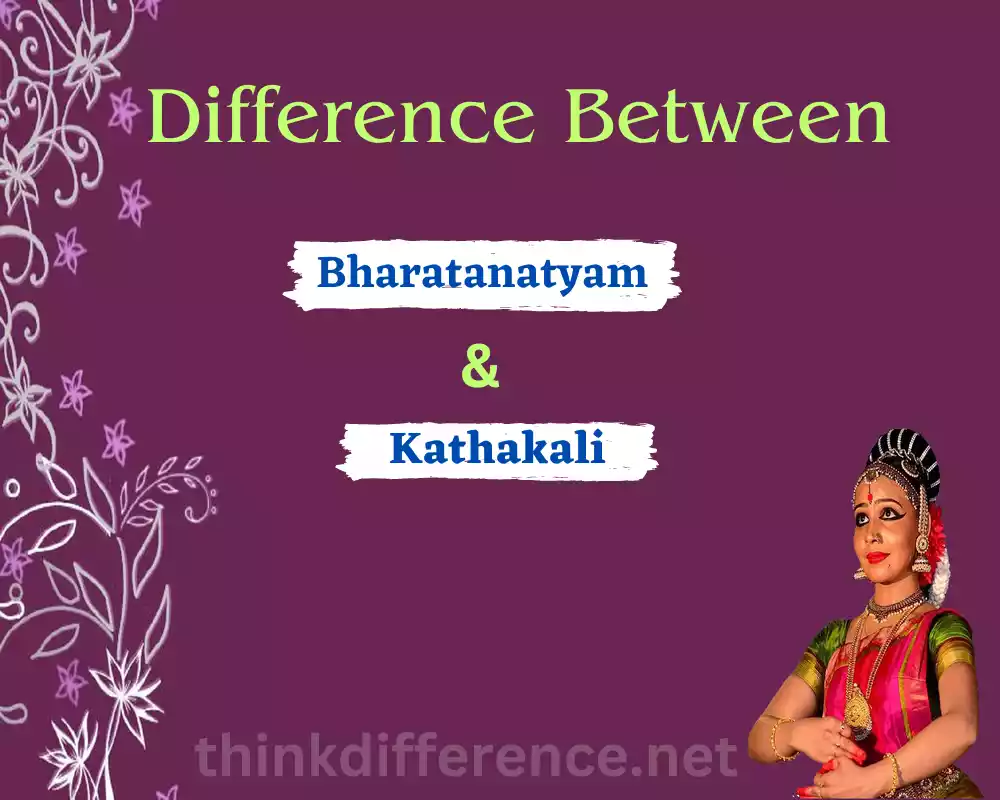Overview of Bharatanatyam and Kathakali
Bharatanatyam and Kathakali are two prominent classical dance forms of India, each with its distinctive style, history, and cultural significance. Here’s an overview of Bharatanatyam and Kathakali:
Bharatanatyam:
- Origin and History: Bharatanatyam originated in the temples of Tamil Nadu, South India. It has a rich history that can be traced back to the ancient Tamil texts called the Natya Shastra. Over the centuries, Bharatanatyam has evolved, incorporating elements from various regional dance traditions.
- Technique and Movements: Bharatanatyam is characterized by its precise footwork, intricate hand gestures (mudras), facial expressions, and fluid body movements. It emphasizes rhythmic patterns (nritta) as well as expressive storytelling (nritya), combining grace, strength, and precision.
- Themes and Repertoire: Bharatanatyam repertoire includes a wide range of themes, including mythological stories, devotional compositions, and poetic expressions. Dancers portray various characters from Hindu mythology, using intricate gestures and expressions to convey narratives and emotions.
- Music and Instruments: Bharatanatyam is accompanied by Carnatic music, a traditional South Indian classical music style. Vocalists, instrumentalists, and percussionists provide live music during performances. Instruments commonly used include the mridangam (double-headed drum), violin, flute, and cymbals.
Kathakali:
- Origin and History: Kathakali originated in the state of Kerala, South India. Starts to develop around the late 17th century; involves drama, dance, music, and religious ceremonies as part of its repertoire. Kathakali draws heavily from ancient Sanskrit texts and Kerala’s traditional performing arts.
- Technique and Movements: Kathakali is known for its highly stylized and dramatic movements. It incorporates elaborate facial expressions, eye movements, hand gestures, and rhythmic footwork. The performers wear elaborate makeup, colorful costumes, and ornate headgear that represent different characters.
- Dramatic Storytelling: Kathakali specializes in portraying mythological stories and epics, particularly those from the Ramayana and the Mahabharata. The dancers bring characters to life through exaggerated expressions, intense emotions, and intricate gestures, capturing the essence of the narrative.
- Music and Instruments: Kathakali performances are accompanied by traditional Kerala percussion instruments such as chenda, mandala and chengila, along with cymbals and the ilathalam. The music, called “Sopanam,” is known for its distinctive rhythms, melodic patterns and vocalizations.
Both Bharatanatyam and Kathakali are revered as significant cultural treasures and have made substantial contributions to the Indian classical dance tradition. While Bharatanatyam focuses on grace, precision and storytelling through intricate movements, Kathakali stands out for its dramatic expressions, elaborate makeup and larger-than-life performances. These dance forms continue to be celebrated, performed and admired for their artistic depth, cultural heritage and captivating performances.
What is Bharatanatyam?
Bharatanatyam is one of the oldest and most celebrated classical dance forms of India. As part of southern Tamil Nadu state, Kancheepuram plays an essential part of culture and religious traditions within this area. Bharatanatyam is known for its grace, precision, intricate footwork, expressive movements and intricate hand gestures (mudras).

Bharatanatyam derives its name from three Sanskrit words, including “Bhava” (expression), “Raga” (music) “Tala” (rhythm) and “Tala” (rhythm). Together, these elements form the foundation of Bharatanatyam, creating a beautiful and harmonious synthesis of movement, music and expression.
The dance form encompasses both Nritta (pure dance) and Nritya (expressive dance). Nritta focuses on intricate footwork, rhythmic patterns and complex body movements, showcasing the technical skill of the dancer. Nritya, on the other hand, emphasizes storytelling, emotional expression and interpretation of lyrics through facial expressions (abhinaya), hand gestures (mudras) and body postures.
Bharatanatyam performances often follow a structured format, beginning with an invocation to the gods, known as the “Pushpanjali.” This is followed by a series of pure dance sequences called “Alarippu,” which showcase the dancer’s skill in executing precise footwork and rhythmic patterns.
The expressive aspect of Bharatanatyam is further explored through the presentation of various pieces, such as “Varnam,” which is a complex composition combining intricate dance movements and expressive storytelling. Other pieces include “Padam,” which focuses on expressing emotions and “Tillana,” which highlights the beauty of pure dance and rhythm.
The dance form is accompanied by Carnatic music, a classical genre from South India. The music includes melodic instruments like the violin, veena and flute, as well as percussion instruments such as the mridangam and cymbals.
Bharatanatyam performances are characterized by vibrant costumes and jewelry. The dancers typically wear colorful silk sarees, intricately designed jewelry and elaborate makeup that accentuates their expressions and features.
Bharatanatyam is not just a form of artistic expression but also serves as a means of spiritual and emotional communication. It carries forward the rich cultural heritage of South India, with its themes often drawn from Hindu mythology and folklore.
Today, Bharatanatyam continues to be cherished and performed by both male and female dancers worldwide, showcasing the beauty, grace and cultural significance of this classical dance form.
What is Kathakali?
Kathakali is a classical dance-drama form that originated in the southern Indian state of Kerala. Known for its vibrant and dramatic performances, Kathakali combines elements of dance, music, theater and ritual. It is characterized by its elaborate makeup, ornate costumes, stylized movements and powerful storytelling.

Kathakali, or Story Theatre as it’s more commonly referred to, derives its name from two Malayalam words that mean: “Katha” meaning story and “Kali” for performance. As its name implies, Kathakali often depicts tales adapted from Indian epics such as Ramayana or Mahabharata and tell them through storytelling performances. The dancers, through their expressive movements and gestures, bring these mythological tales to life on the stage.
One of the distinctive features of Kathakali is its elaborate makeup or “Chutti.” The performers spend hours applying makeup, using vibrant colors and intricate patterns to depict different characters. Makeup not only enhances our appearance but it is also used as an invaluable way of conveying personality traits such as emotion or status in society.
The costumes in Kathakali are equally striking. The performers wear colorful, intricately designed costumes made of rich fabrics, often adorned with ornaments and accessories. The attire varies depending on the character being portrayed, ranging from gods and goddesses to demons and noble characters.
The movements in Kathakali are highly stylized and symbolic, with great emphasis on eye movements, facial expressions, hand gestures (mudras) and body postures. Each movement carries specific meanings and is carefully executed to convey the emotions, moods and actions of the characters.
Kathakali performances are accompanied by a unique style of music known as “Sopanam.” The musical ensemble typically consists of vocalists, percussion instruments like chenda and maddalam and melodic instruments like the chengila (gong) and ilathalam (cymbals). The music adds depth, rhythm and emotional resonance to the performance.
Kathakali performances are traditionally held in temples and other sacred spaces. Dance-drama’s unique, immersive style combined with ritualistic aspects create an exhilarating and transformative experience for both audience members and performers alike.
Over the years, Kathakali has gained international recognition and appreciation for its grandeur, expressive power and cultural significance. It continues to be performed and taught, preserving the rich artistic heritage of Kerala and serving as a testament to the storytelling traditions of India.
Importance and popularity of Bharatanatyam and Kathakali
Both Bharatanatyam and Kathakali hold immense importance and enjoy widespread popularity, both within India and across the world. Here are some key points highlighting the significance and popularity of these dance forms:
Bharatanatyam:
- Cultural Heritage: Bharatanatyam is deeply ingrained in the cultural heritage of South India, particularly Tamil Nadu. Culture and tradition play an essential role in any region’s heritage and identity.
- Spiritual and Devotional Connection: Bharatanatyam is often performed as a form of devotion and spiritual expression. It is closely associated with temple rituals and is considered a sacred art form, allowing practitioners to connect with the divine.
- Artistic Excellence and Aesthetic Appeal: Bharatanatyam is celebrated for its artistic excellence, intricate movements and aesthetic beauty. Elegant footwork combined with expressive hand gestures and emotive facial expressions makes for an engaging viewing experience for viewers.
- International Recognition: Bharatanatyam has gained global recognition and appreciation. It has transcended cultural boundaries and is performed and taught in numerous countries around the world, contributing to its popularity and exposure.
- Professional Opportunities: Bharatanatyam offers professional opportunities for dancers, including solo performances, group productions, collaborations with musicians and participation in prestigious dance festivals. Many dancers also establish their own dance schools and pass on the art form to future generations.
Kathakali:
- Cultural Emblem of Kerala: Kathakali is often considered the cultural emblem of Kerala, showcasing the state’s rich artistic heritage and traditions. It is celebrated as an iconic symbol of Kerala’s cultural identity.
- Dramatic Storytelling: Kathakali’s dramatic storytelling captivates audiences with its larger-than-life characters, vivid expressions and intense emotions. It brings to life mythological tales and epic narratives, engaging viewers in a powerful and immersive experience.
- Visual Splendor and Makeup: Kathakali’s elaborate makeup, vibrant costumes and ornate jewelry contribute to its visual splendor. The distinctive makeup styles and intricate detailing of the characters enhance the overall impact and make it visually stunning.
- Tourism and Cultural Attraction: Kathakali has become a significant attraction for tourists visiting Kerala. Music, dance, visual aesthetics and theater combine in this innovative performance to draw visitors from around the globe and contribute to tourism growth in the region.
- Preservation of Traditional Art Forms: Kathakali plays a crucial role in preserving and promoting traditional art forms, music, and literature of Kerala. It serves as a platform for passing down ancient stories, techniques and cultural practices to future generations.
The importance and popularity of Bharatanatyam and Kathakali lie in their ability to preserve cultural heritage, evoke deep emotions and create profound artistic experiences. These dance forms continue to be cherished, admired and celebrated, contributing to the vibrancy and diversity of India’s performing arts landscape.
Differences between Bharatanatyam and Kathakali
Bharatanatyam and Kathakali are two distinct classical dance forms of India, each with its own unique characteristics and styles. Here are some key differences between Bharatanatyam and Kathakali:
- Origin and Regional Association:
- Bharatanatyam: Originated in Tamil Nadu, South India.
- Kathakali: Originated in Kerala, South India.
- Technique and Movements:
- Bharatanatyam: Emphasizes intricate footwork, graceful movements and precise hand gestures (mudras).
- Kathakali: Focuses on stylized movements, including elaborate facial expressions, eye movements and powerful body postures.
- Expressions and Storytelling:
- Bharatanatyam: Incorporates both pure dance (Nritta) and expressive dance (Nritya), with a strong emphasis on conveying emotions and storytelling through facial expressions (abhinaya) and hand gestures.
- Kathakali: Primarily a dance-drama form, with an emphasis on dramatic storytelling through elaborate makeup, facial expressions and body movements. The focus is on bringing mythological characters to life on stage.
- Costumes and Makeup:
- Bharatanatyam: Dancers wear colorful silk sarees, intricately designed jewelry, and minimal makeup.
- Kathakali: Known for its elaborate makeup (Chutti) with vibrant colors and intricate patterns. The costumes are ornate and often depict specific characters, utilizing vibrant fabrics, headgear and accessories.
- Music and Rhythm:
- Bharatanatyam: Accompanied by Carnatic music, a classical genre from South India, which includes melodic instruments like the violin and flute, as well as percussion instruments like the mridangam.
- Kathakali: Features a unique style of music called “Sopanam,” characterized by vocal recitations, percussion instruments like chenda and maddalam and melodic instruments like the gong and cymbals.
- Theme and Repertoire:
- Bharatanatyam: Explores a wide range of themes, including mythology, devotion and human emotions. The repertoire includes abstract dance sequences, as well as narrative compositions.
- Kathakali: Primarily focuses on depicting stories from Indian epics, particularly the Ramayana and Mahabharata. The repertoire includes specific characters and episodes from these epics.
- Performance Style and Presentation:
- Bharatanatyam: Typically performed on a stage, with solo or group performances. The emphasis is on the dancer’s skill, precision, and expressiveness.
- Kathakali: Often performed in temple courtyards or open-air spaces, with a larger ensemble cast including dancers, musicians, and vocalists. The performances are highly theatrical, grand and immersive.
It’s important to note that both Bharatanatyam and Kathakali are highly revered classical dance forms, showcasing the cultural richness and artistic traditions of India. While they have distinct characteristics, they both contribute to the diverse tapestry of Indian performing arts.
Similarities between Bharatanatyam and Kathakali
While Bharatanatyam and Kathakali are distinct classical dance forms with their own unique styles and characteristics, there are also some similarities between the two:
- Classical Indian Dance Forms: Both Bharatanatyam and Kathakali are prominent classical dance forms of India, deeply rooted in the cultural and artistic traditions of the country.
- Expressive Elements: Both dance forms emphasize the use of facial expressions, eye movements and hand gestures (mudras) to convey emotions, tell stories and portray characters. Both Bharatanatyam and Kathakali rely on the expressiveness of the dancers to communicate narratives and evoke sentiments.
- Mythological Themes: Both dance forms draw inspiration from Indian mythology and epics. They often depict stories and characters from Hindu epics like the Ramayana and the Mahabharata, bringing mythological tales to life through movement and expression.
- Rigorous Training and Discipline: Both Bharatanatyam and Kathakali require years of dedicated training, discipline, and mastery of intricate techniques. The dancers undergo rigorous physical and mental training to develop their skills, precision, and expressiveness.
- Connection to Music and Rhythm: Both dance forms are closely tied to music and rhythm. Bharatanatyam is accompanied by classical Carnatic music, while Kathakali has its unique style of music called “Sopanam.” In both dance forms, the movements and expressions of the dancers are intricately coordinated with the musical rhythms and melodies.
- Cultural Significance: Both Bharatanatyam and Kathakali hold immense cultural significance in their respective regions. They are considered integral parts of the cultural heritage and identity of South India, representing the rich artistic traditions of the states of Tamil Nadu and Kerala.
- Performative Elements: Both dance forms feature elaborate costumes and jewelry, creating a visual spectacle on stage. The dancers in both Bharatanatyam and Kathakali undergo meticulous makeup application to enhance their expressions and portray specific characters.
- Storytelling and Narratives: Both Bharatanatyam and Kathakali are narrative forms of dance, where the dancers use their movements and expressions to tell stories and convey emotions. They bring to life the characters and episodes from the mythology, capturing the attention and imagination of the audience.
Despite their differences, Bharatanatyam and Kathakali share these commonalities as cherished classical dance forms, embodying the artistic traditions and cultural heritage of India.
Training and techniques
Training and techniques in Bharatanatyam and Kathakali involve rigorous practice, discipline and mastery of specific skills. There can be variations between their methods of training and methodologies.
Here’s an overview of the training and techniques in each dance form:

Bharatanatyam:
- Adavus and Footwork: Bharatanatyam training begins with learning adavus, which are basic steps that form the foundation of the dance form. Adavus include various footwork patterns, body movements and hand gestures. Students gradually progress to more complex adavus as they advance in their training.
- Hand Gestures (Mudras): Bharatanatyam places significant emphasis on precise hand gestures or mudras. There are numerous mudras representing different elements, emotions and objects. Students learn to master these mudras, which are intricately coordinated with facial expressions and body postures.
- Abhinaya (Expression): Bharatanatyam training focuses on developing expressive skills through abhinaya. Students learn to convey various emotions and tell stories using facial expressions, eye movements and body language. They undergo training to portray different characters, their emotions and the nuances of storytelling.
- Natya Shastra: Bharatanatyam training often includes studying the Natya Shastra, an ancient treatise on performing arts. This text provides detailed guidance on various aspects of dance, including technique, aesthetics and expression.
- Music Training: Bharatanatyam dancers receive training in Carnatic music, as it forms an integral part of the dance form. They learn to understand and interpret the melodic patterns, rhythmic structures and nuances of the music accompanying their performances.
Kathakali:
- Physical Conditioning: Kathakali training involves rigorous physical conditioning to develop strength, stamina and flexibility. This includes exercises, body postures and movements that help dancers achieve the required physicality and endurance for the demanding performances.
- Eye Movements (Navarasam): Kathakali is known for its elaborate eye movements, known as navarasam. Dancers undergo specialized training to master the precise and intricate eye movements that convey various emotions, moods and character traits.
- Facial Expressions and Makeup: Kathakali dancers learn to use elaborate facial expressions to portray different characters. They also undergo training in the application of makeup (chutti) and the nuances of facial transformations that help distinguish the different characters on stage.
- Kalaripayattu Influence: Kathakali training is often complemented by training in Kalaripayattu, a traditional Indian martial art form. Kalaripayattu helps dancers develop strength, agility and control over their movements.
- Voice Training: Kathakali dancers also receive training in vocal techniques, enabling them to produce vocalizations and recitations during performances. They learn to modulate their voice to match the character’s emotions and the narrative of the story.
Both Bharatanatyam and Kathakali require years of dedicated training under the guidance of experienced gurus (teachers) to master their respective techniques and performance skills. The training in both dance forms emphasizes discipline, dedication and a deep understanding of the art form’s cultural and aesthetic nuances.
Significance and cultural impact
Both Bharatanatyam and Kathakali hold immense significance and have made a substantial cultural impact in the Indian arts scene. Here are some key points regarding their significance and cultural impact:
Bharatanatyam:
- Cultural Heritage: Bharatanatyam is deeply rooted in the cultural heritage of Tamil Nadu, South India. Dancing has long been part of Indian tradition and remains one of the oldest classical dance forms. Generation after generation has preserved and passed down this dance form to enrich regional identity and strengthen identity within communities.
- Spiritual and Devotional Expression: Bharatanatyam has strong ties to Hinduism and temple rituals. It is often performed as a form of devotion and spiritual expression, with many dance compositions dedicated to gods and goddesses. The dance form serves as a means of connecting with the divine and expressing reverence.
- Artistic Excellence and Discipline: Bharatanatyam requires rigorous training, discipline and a high level of technical proficiency. Dancers spend years honing their skills, developing precision in footwork, hand gestures and expressions. The pursuit of artistic excellence in Bharatanatyam reflects the commitment to preserving and elevating the classical arts.
- Storytelling and Cultural Narratives: Bharatanatyam is known for its ability to tell stories through expressive movements and gestures. It brings to life mythological tales, folklore and historical narratives, helping to preserve and transmit cultural stories and traditions to future generations.
- Global Recognition: Bharatanatyam has gained international recognition and has been embraced by artists and audiences around the world. Its elegance, expressive power and cultural significance have contributed to its popularity and widespread appreciation beyond the borders of India.
Kathakali:
- Cultural Emblem of Kerala: Kathakali is often considered the cultural emblem of the state of Kerala. It is deeply intertwined with the cultural fabric of Kerala and is celebrated as a symbol of its artistic heritage.
- Mythological Epics and Folklore: Kathakali predominantly draws inspiration from Indian epics like the Ramayana and Mahabharata. It brings to life epic characters and stories, preserving and showcasing the rich mythological and folkloric traditions of Kerala.
- Visual Spectacle and Theater: Kathakali’s elaborate costumes, intricate makeup and vibrant expressions create a visual spectacle. The dance-drama form incorporates theatrical elements, with a focus on dramatic storytelling, powerful emotions, and larger-than-life characters.
- Preserving Ancient Art Forms: Kathakali plays a vital role in preserving and promoting ancient art forms, music and literature of Kerala. It serves as a platform for passing down traditional knowledge and techniques to future generations, ensuring the continuity of cultural heritage.
- Tourism and Cultural Exchange: Kathakali has become a significant attraction for tourists visiting Kerala. Its distinctive visual appeal, captivating performances and cultural depth attract visitors from around the world. Kathakali has also played a role in cultural exchanges, with artists traveling abroad to perform and share the art form with global audiences.
Both Bharatanatyam and Kathakali, through their artistic excellence, cultural depth and storytelling prowess, have contributed to the preservation and promotion of India’s diverse cultural heritage. They continue to inspire and engage audiences, serving as cultural ambassadors and symbols of artistic excellence.
Conclusion
Bharatanatyam and Kathakali stand as testaments to India’s artistic brilliance and cultural diversity. These classical dance forms mesmerize audiences with their expressive storytelling, vivid performances, and spiritual depth. As the world evolves, it is imperative to cherish and sustain these captivating art forms, ensuring they continue to enthrall generations to come.



